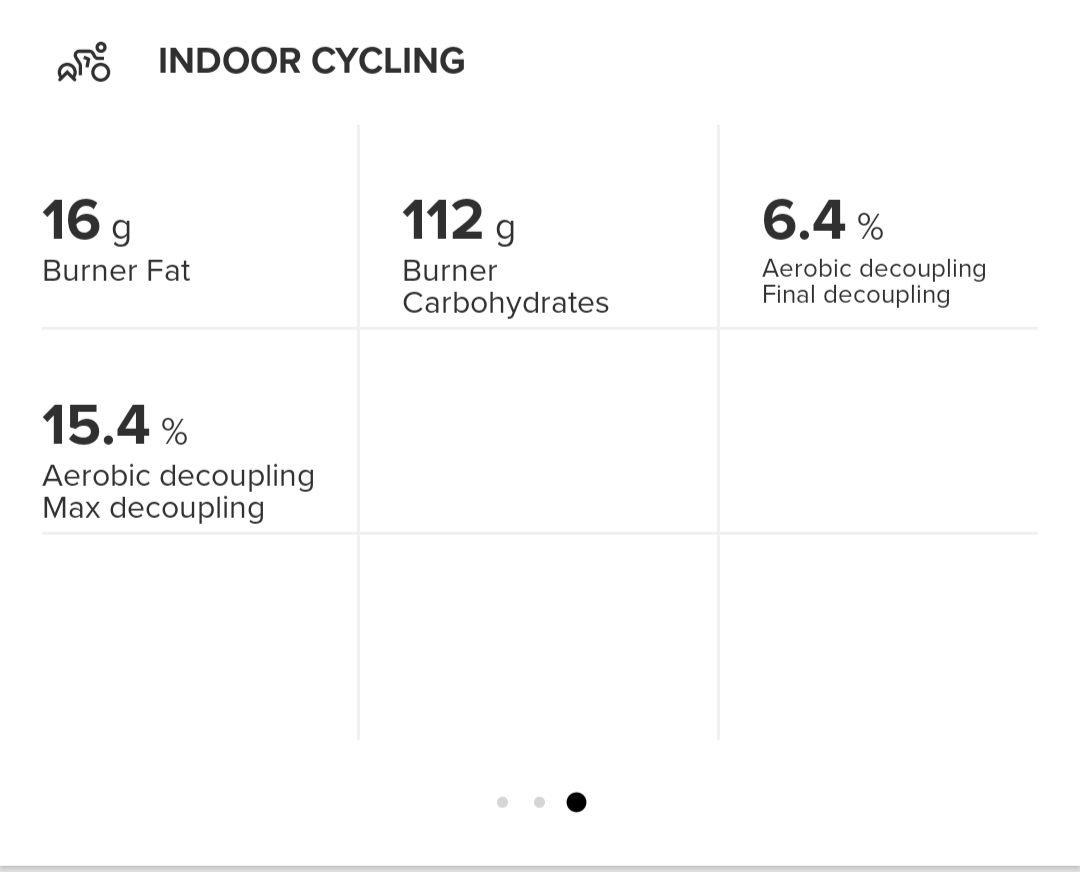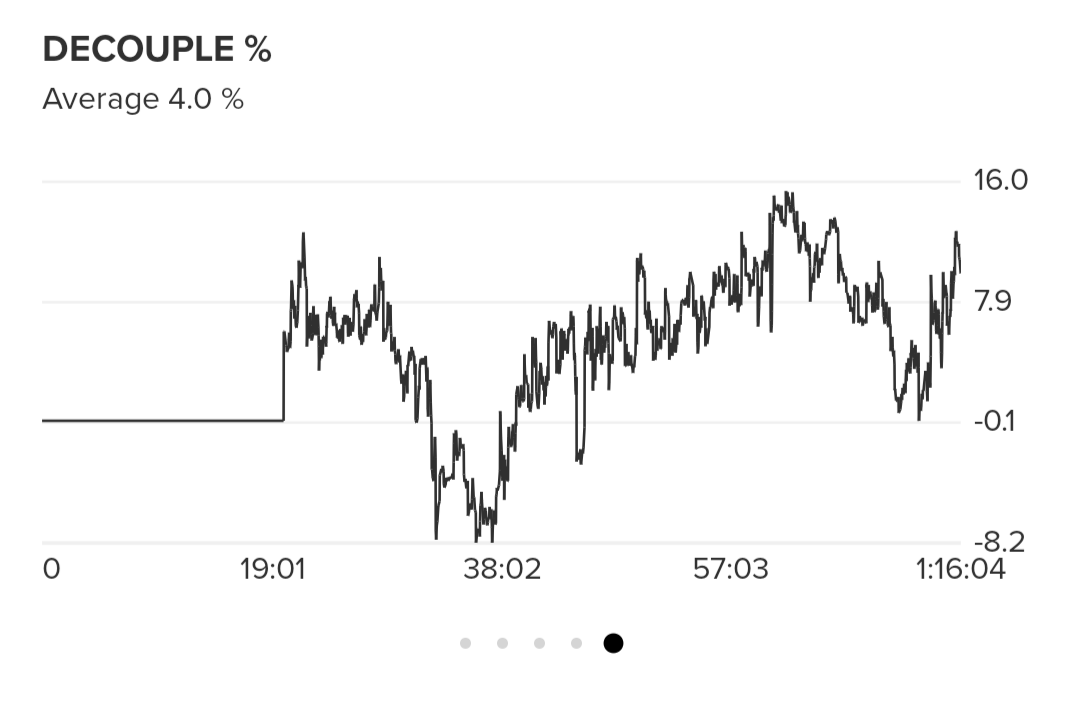aerobic decoupling
-
Hi,
I’ve always done the math to calculate it with my AW… and I’ve just discovered that there’s a S+ that does the boring calculation for me and I’ve also it in real time. Oh boys…

-
@ultravox The realtime is particularly helpful for estimating your Aerobic Threshold as you can dial up or down the pace to see what happens in the display. In addition, I use this on long runs with power hiking where I am attempting to avoid going too hard. I like this one a lot!
-
@Brad_Olwin said in aerobic decoupling:
@ultravox I use this on long runs with power hiking where I am attempting to avoid going too hard

-
I isazi moved this topic from The Lounge on
-
I’ve been playing around with the aerobic decoupling S+ app, and while I’m not a professional athlete by any means, it seems like it would still be useful as a kind of fitness test. However, I don’t really understand the data I’m getting: I just came back from a 25km run with a fairly steady pace and HR, and the decoupling app showed less than 5% for almost the entire run, as confirmed also by the graphs in the phone app after the run. But then in the activity overview grid, it shows a 7.1% “aerobic decoupling decouple value”, so I’m trying to understand how to make sense of the two together. That is, where does that 7.1% come from? It’s definitely not the average value for the entire run, and it doesn’t seem to be the highest value recorded either. And even if it’s the highest value, then what is the use of that? There’s a set of steep stairs near my house that I almost always run up at the end of a run, and naturally the value goes up there because of the decrease in pace and increase in HR, but surely those 30 seconds cannot be a useful metric? I’m including a screenshot of today’s run below with pace, HR, and decoupling shown—can anyone help me make sense of this? I use an HR strap. Thanks!

-
@bobson I’m not a pro either, but I can imagine that this app is not perfectly developed yet, especially with the data that SA displays after running an activity with it. I reported something similar about the Running Economy app, some fields seem to be duplicates although showing different values. I’d be more curious to hear from the pro’s how they make use of it during the activity.
If you want to use Aerobic Decoupling as an indicator of your form, I can suggest analysing it with intervals.icu that allows you also to trim some of the first and last part of an activity; that might be useful for you if you want to exclude, for example, the steps at the end of your run. -
Pro, no pro, beginner, metrics are useful if input is valid. When you have technical terrain, windy conditions, etc, watch will try to filter data to get accurate altitude via gps and baro sensor. Those errors are visible in your graph as decoupling values. If you want to do a test I suggest doing it on a flat terrain without too much windy conditions and if your altitude profile is flat on a watch and in reality you can assume test is valid. Other factors include kinematics that are different when you climb stairs vs run on flat and surface, surface also influences your power but power calculation cannot account for it. Thats why you try to keep all constant (flat terrain, same surface, no wind gusts or large air pressure changes).
App also does not rely on NGP but pace or power, and power for ascending does not have same efficiency as power for flat running, so you will see decoupling. Grade on which you are climbing have
Different efficiency factors also.If you have a long steady climb, then you could use it as there aren’t many variations while ascending.
For biking it is same, power/hr does depend if you are pedaling off seat or on seat and at what cadence
Producing 200W at 60 cadence will have different efficiency than producing 200W at 90.
Good part about bike decoupling is that you can ignore altitude errors and your output is power meter load cell.
But when you bike and coast you decoupled your power while your heart is still beating fast, and lo and behold your decoupling values are not correct. -
@Brad_Olwin I use it a lot too, but I miss the ability to see other metrics, e.g., pace/power, at the same time and once the activity is over set Z1 and Z2 accordingly if decoupling is in between 3.5-5%
-
@A-Former-User said in aerobic decoupling:
I miss the ability to see other metrics, e.g., pace/power, at the same time and once the activity is over set Z1 and Z2 accordingly if decoupling is in between 3.5-5%
I’m voting for this too!
-
On the Suunto Race, the “aerobic decoupling” app seems to calculate an estimate of the aerobic coupling instead of decoupling as can be seen from the screenshot below. This is the case both on watch itself and also in the Suunto App. It is not a big issue as the decoupling value is just “100% - coupling”.
However, as can be seen in the screenshot below then the decoupling (which is actually coupling) figure has a different and wrong average than what is reported in the top of the screenshot. The whole decoupling figure looks strange with the deep periodic dips.
Note, this is a cycling activity.

-
-
@Mads-Hintz-Madsen Thank you for the feedback. Decoupling value is obviously wrong as you said, I’m not sure if it’s showing coupling value or if the value is otherwise incorrect. We will investigate it.
The value in summary is actually not average, it is the final decoupling value. It should be renamed to e.g. “Final decouple value” to avoid confusion. I guess the thinking behind the summary value is that final value is usually the maximum, of course it depends on your workout. We could add also maximum value to summary.
-
@Raimo-Järvi Thanks for the quick reply and for following up on this issue

-
When power output is zero(coasting), does it exclude coupling data with HR?
-
@lexterm77 When speed AND power are zero, decoupling value is not calculated. When only power is zero, it is calculated. So the answer to your question is no. But maybe it should be excluded, it seems logical to me to exclude coasting.
-
We published an update to Aerobic decoupling app. It fixes a bug in calculating decoupling value for cycling. It also renames summary ‘Decouple value’ to ‘Final decoupling’ for clarity and adds ‘Max decoupling’ to summary.
Zero power / coasting is not excluded from decoupling calculation yet, we will fix that and publish another update.
-
@Raimo-Järvi great! Thx for the quick response

I will try it out as soon as I can.
EDIT: Btw, I don’t understand the reasoning for wanting to exclude coasting/zero power from the calculations.
Why should zero power be treated differently than e.g. soft pedalling at 1 Watt? I believe that aerobic decoupling metric is using normalized power (NP) which is already dealing gracefully with periods of low power output such as 0 or e.g. 1 Watt.
-
@Raimo-Järvi I did an inside Zwift cycling activity using the updated aerobic decoupling app.
I have included screenshots below of the decoupling data shown in Suunto App. It seems like the final decoupling value (6.4%) in the first screenshot now makes sense.
However, I don’t think that the max decoupling value (15.4%) provides any useful information. This is the maximum instantaneous (i.e. calculated using instantaneous power and heart rate) decoupling value which could even be 100% by simply stopping pedalling, i.e., power goes to zero (I forgot to actually try). So I believe that the max. value can be whatever value from activity to activity and is not really worth tracking. This may confuse some people.
The second screenshot shows the instantaneous decoupling (which can be both positive and negative as can also be seen). And here I believe that the average decoupling value (4.0%) is just the average of the instantaneous decoupling. This average will in general be different from the final decoupling value. I assume that the average and final decoupling value will be close if the ride is done at more or less constant power or heart rate.
Final remark (or advice to any users of this metric) is that the aerobic decoupling metric only really makes (scientific) sense if the activity is performed at constant power or heart rate as the metric measures changes in the power-to-heartrate ratio. This is not a linear relationship so the metric will lose its meaning if there are big fluctuations in e.g. power.
I’m not sure that I will be using this S+ app much but after the latest update, the calculations seem to be correct. Thanks for that!!!
Sorry for rambling on! I’ll go to sleep now



-
EDIT: Btw, I don’t understand the reasoning for wanting to exclude coasting/zero power from the calculations.
Because your heart continues to beat even when you stop power output. So HR data is no longer “coupled” or relevant to a calculation. If you include it by doing 0 watt power output and your heart still beating, you are invalidating coupling calculation.
-
@lexterm77 hmm, I’m still not sure I get why 0W needs a special handling compared to say 1W.
The decoupling equation uses normalized power (NP) calculated from the entire activity. NP effectively de-weights periods with low power output such as 0 W. That is why I think that 0 W values (or other relativity low power values) do not need to be excluded from the metric as NP gracefully handles periods with lower power. That is why NP was invented in the first place.
But maybe the thinking/assumption is that you pedal at either approx. constant power or that you are coasting at 0W and that is why it is being proposed to do special handling of exactly 0W.
-
Normalized power is for calculating your overall effort. Not useful in testing of aerobic threshold. If you go to a lab, they will tell you never, i mean not even for a second to stop pedaling. This is why aerobic threshold tests are not really valid if you do 30min effort then pause 2 minutes then resume. Your anaerobic or oxygen debt or epoc will be refilled and whole teat goes into trash bin. Just go to any lab and ask. They will tell you you need nearly constant effort for 60min to get a valid test.